DODGE RAM 2003 Service Repair Manual
Manufacturer: DODGE, Model Year: 2003, Model line: RAM, Model: DODGE RAM 2003Pages: 2895, PDF Size: 83.15 MB
Page 2641 of 2895
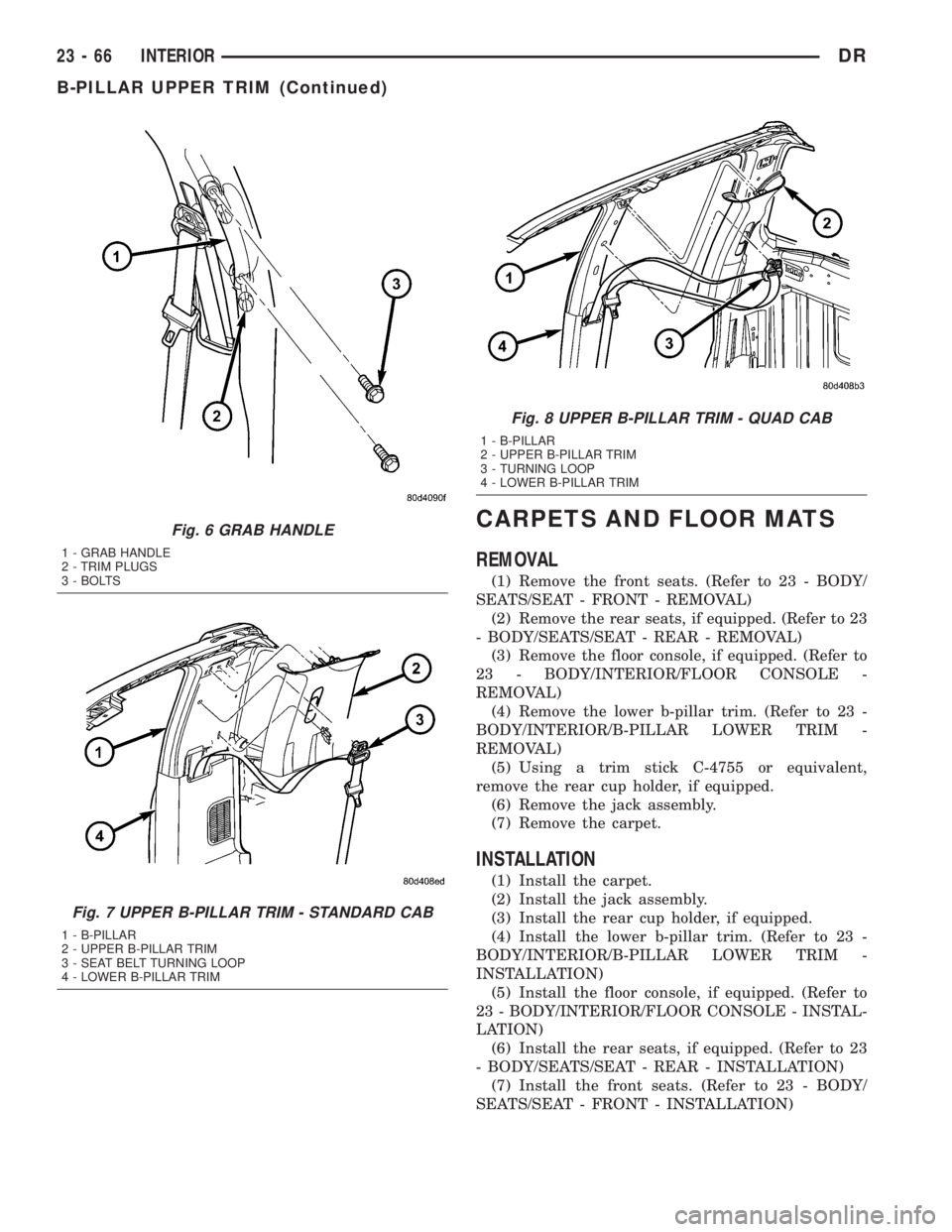
CARPETS AND FLOOR MATS
REMOVAL
(1) Remove the front seats. (Refer to 23 - BODY/
SEATS/SEAT - FRONT - REMOVAL)
(2) Remove the rear seats, if equipped. (Refer to 23
- BODY/SEATS/SEAT - REAR - REMOVAL)
(3) Remove the floor console, if equipped. (Refer to
23 - BODY/INTERIOR/FLOOR CONSOLE -
REMOVAL)
(4) Remove the lower b-pillar trim. (Refer to 23 -
BODY/INTERIOR/B-PILLAR LOWER TRIM -
REMOVAL)
(5) Using a trim stick C-4755 or equivalent,
remove the rear cup holder, if equipped.
(6) Remove the jack assembly.
(7) Remove the carpet.
INSTALLATION
(1) Install the carpet.
(2) Install the jack assembly.
(3) Install the rear cup holder, if equipped.
(4) Install the lower b-pillar trim. (Refer to 23 -
BODY/INTERIOR/B-PILLAR LOWER TRIM -
INSTALLATION)
(5) Install the floor console, if equipped. (Refer to
23 - BODY/INTERIOR/FLOOR CONSOLE - INSTAL-
LATION)
(6) Install the rear seats, if equipped. (Refer to 23
- BODY/SEATS/SEAT - REAR - INSTALLATION)
(7) Install the front seats. (Refer to 23 - BODY/
SEATS/SEAT - FRONT - INSTALLATION)
Fig. 6 GRAB HANDLE
1 - GRAB HANDLE
2 - TRIM PLUGS
3 - BOLTS
Fig. 7 UPPER B-PILLAR TRIM - STANDARD CAB
1 - B-PILLAR
2 - UPPER B-PILLAR TRIM
3 - SEAT BELT TURNING LOOP
4 - LOWER B-PILLAR TRIM
Fig. 8 UPPER B-PILLAR TRIM - QUAD CAB
1 - B-PILLAR
2 - UPPER B-PILLAR TRIM
3 - TURNING LOOP
4 - LOWER B-PILLAR TRIM
23 - 66 INTERIORDR
B-PILLAR UPPER TRIM (Continued)
Page 2642 of 2895
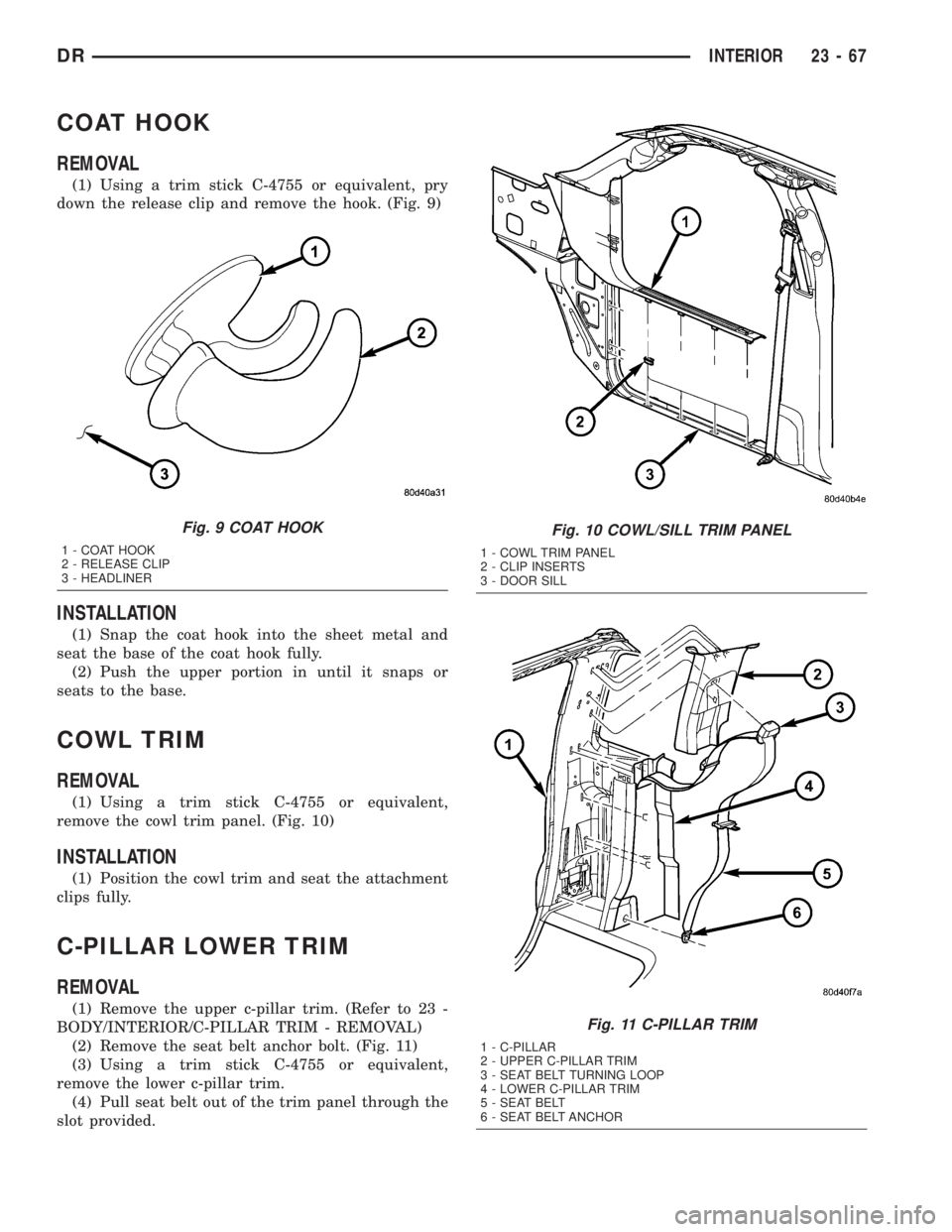
COAT HOOK
REMOVAL
(1) Using a trim stick C-4755 or equivalent, pry
down the release clip and remove the hook. (Fig. 9)
INSTALLATION
(1) Snap the coat hook into the sheet metal and
seat the base of the coat hook fully.
(2) Push the upper portion in until it snaps or
seats to the base.
COWL TRIM
REMOVAL
(1) Using a trim stick C-4755 or equivalent,
remove the cowl trim panel. (Fig. 10)
INSTALLATION
(1) Position the cowl trim and seat the attachment
clips fully.
C-PILLAR LOWER TRIM
REMOVAL
(1) Remove the upper c-pillar trim. (Refer to 23 -
BODY/INTERIOR/C-PILLAR TRIM - REMOVAL)
(2) Remove the seat belt anchor bolt. (Fig. 11)
(3) Using a trim stick C-4755 or equivalent,
remove the lower c-pillar trim.
(4) Pull seat belt out of the trim panel through the
slot provided.
Fig. 9 COAT HOOK
1 - COAT HOOK
2 - RELEASE CLIP
3 - HEADLINER
Fig. 10 COWL/SILL TRIM PANEL
1 - COWL TRIM PANEL
2 - CLIP INSERTS
3 - DOOR SILL
Fig. 11 C-PILLAR TRIM
1 - C-PILLAR
2 - UPPER C-PILLAR TRIM
3 - SEAT BELT TURNING LOOP
4 - LOWER C-PILLAR TRIM
5 - SEAT BELT
6 - SEAT BELT ANCHOR
DRINTERIOR 23 - 67
Page 2643 of 2895

INSTALLATION
(1) Route the shoulder belt through the slot in the
trim.
(2) Position the trim and seat the attachment clips
fully.
(3) Install the seat belt anchor bolt and tighten to
40 N´m (30 ft. lbs.).
(4) Install the upper c-pillar trim. (Refer to 23 -
BODY/INTERIOR/C-PILLAR UPPER TRIM -
INSTALLATION)
C-PILLAR UPPER TRIM
REMOVAL
(1) Remove the seat belt turning loop. (Refer to 8 -
ELECTRICAL/RESTRAINTS/SEAT BELT TURNING
LOOP ADJUSTER - REMOVAL)
(2) Using a trim stick C-4755 or equivalent,
remove the upper c-pillar trim. (Fig. 11)
INSTALLATION
(1) Position the upper c-pillar trim and seat the
attachment clips fully.
(2) Install the seat belt turning loop. (Refer to 8 -
ELECTRICAL/RESTRAINTS/SEAT BELT TURNING
LOOP ADJUSTER - INSTALLATION)
FLOOR CONSOLE
REMOVAL
(1) Remove the 4WD shifter boot. (Refer to 23 -
BODY/INTERIOR/4WD FLOOR SHIFT BOOT -
REMOVAL)
(2) Using a trim stick C-4755 or equivalent, pry up
the transmission shifter boot from the console.
(3) Remove the transmission shifter extension.
(4) Remove the console inserts. (Fig. 12)
(5) Remove and discard the three bolts. (Fig. 13)
(6) Lift up on the back and remove the console.
INSTALLATION
(1) Position the front of the console up under the
instrument panel.
(2) Lower the back of the console and install three
new screws.
(3) Install the inserts.
(4) Install the transmission shifter extension.
(5) Position the transmission shifter boot in place
and seat the attachment clips fully.
(6) Install the 4WD shifter boot. (Refer to 23 -
BODY/INTERIOR/4WD FLOOR SHIFT BOOT -
INSTALLATION)
Fig. 12 FLOOR CONSOLE INSERTS
1 - BIN PAD INSERT
2 - STORAGE BIN/SHIFT BOOT
3 - CUP HOLDER INSERT
4 - FLOOR CONSOLE
Fig. 13 FLOOR CONSOLE
1 - INSTRUMENT PANEL
2 - FLOOR CONSOLE
3 - BOLTS (3)
4 - SHIFTER LEVER
23 - 68 INTERIORDR
C-PILLAR LOWER TRIM (Continued)
Page 2644 of 2895
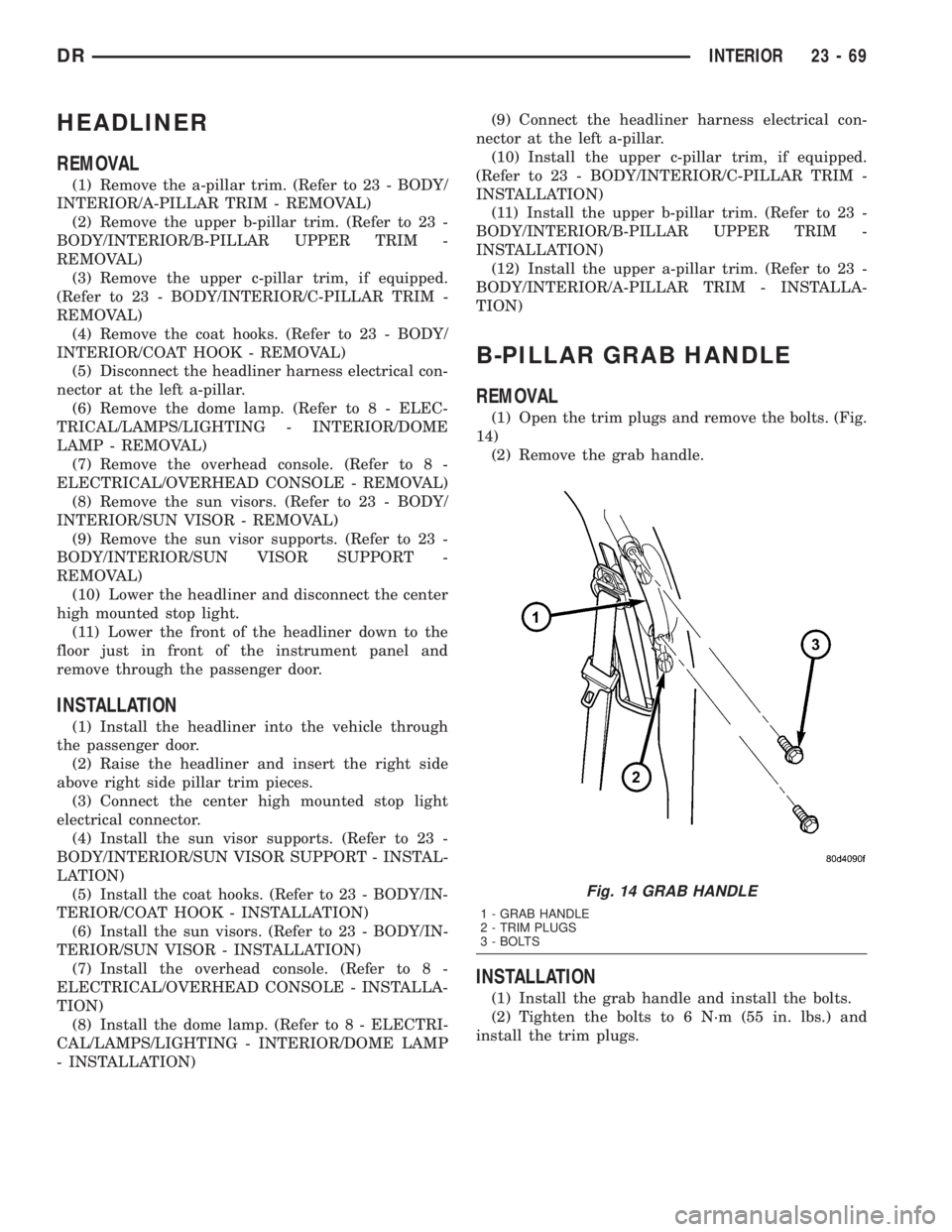
HEADLINER
REMOVAL
(1) Remove the a-pillar trim. (Refer to 23 - BODY/
INTERIOR/A-PILLAR TRIM - REMOVAL)
(2) Remove the upper b-pillar trim. (Refer to 23 -
BODY/INTERIOR/B-PILLAR UPPER TRIM -
REMOVAL)
(3) Remove the upper c-pillar trim, if equipped.
(Refer to 23 - BODY/INTERIOR/C-PILLAR TRIM -
REMOVAL)
(4) Remove the coat hooks. (Refer to 23 - BODY/
INTERIOR/COAT HOOK - REMOVAL)
(5) Disconnect the headliner harness electrical con-
nector at the left a-pillar.
(6) Remove the dome lamp. (Refer to 8 - ELEC-
TRICAL/LAMPS/LIGHTING - INTERIOR/DOME
LAMP - REMOVAL)
(7) Remove the overhead console. (Refer to 8 -
ELECTRICAL/OVERHEAD CONSOLE - REMOVAL)
(8) Remove the sun visors. (Refer to 23 - BODY/
INTERIOR/SUN VISOR - REMOVAL)
(9) Remove the sun visor supports. (Refer to 23 -
BODY/INTERIOR/SUN VISOR SUPPORT -
REMOVAL)
(10) Lower the headliner and disconnect the center
high mounted stop light.
(11) Lower the front of the headliner down to the
floor just in front of the instrument panel and
remove through the passenger door.
INSTALLATION
(1) Install the headliner into the vehicle through
the passenger door.
(2) Raise the headliner and insert the right side
above right side pillar trim pieces.
(3) Connect the center high mounted stop light
electrical connector.
(4) Install the sun visor supports. (Refer to 23 -
BODY/INTERIOR/SUN VISOR SUPPORT - INSTAL-
LATION)
(5) Install the coat hooks. (Refer to 23 - BODY/IN-
TERIOR/COAT HOOK - INSTALLATION)
(6) Install the sun visors. (Refer to 23 - BODY/IN-
TERIOR/SUN VISOR - INSTALLATION)
(7) Install the overhead console. (Refer to 8 -
ELECTRICAL/OVERHEAD CONSOLE - INSTALLA-
TION)
(8) Install the dome lamp. (Refer to 8 - ELECTRI-
CAL/LAMPS/LIGHTING - INTERIOR/DOME LAMP
- INSTALLATION)(9) Connect the headliner harness electrical con-
nector at the left a-pillar.
(10) Install the upper c-pillar trim, if equipped.
(Refer to 23 - BODY/INTERIOR/C-PILLAR TRIM -
INSTALLATION)
(11) Install the upper b-pillar trim. (Refer to 23 -
BODY/INTERIOR/B-PILLAR UPPER TRIM -
INSTALLATION)
(12) Install the upper a-pillar trim. (Refer to 23 -
BODY/INTERIOR/A-PILLAR TRIM - INSTALLA-
TION)
B-PILLAR GRAB HANDLE
REMOVAL
(1) Open the trim plugs and remove the bolts. (Fig.
14)
(2) Remove the grab handle.
INSTALLATION
(1) Install the grab handle and install the bolts.
(2) Tighten the bolts to 6 N´m (55 in. lbs.) and
install the trim plugs.
Fig. 14 GRAB HANDLE
1 - GRAB HANDLE
2 - TRIM PLUGS
3 - BOLTS
DRINTERIOR 23 - 69
Page 2645 of 2895
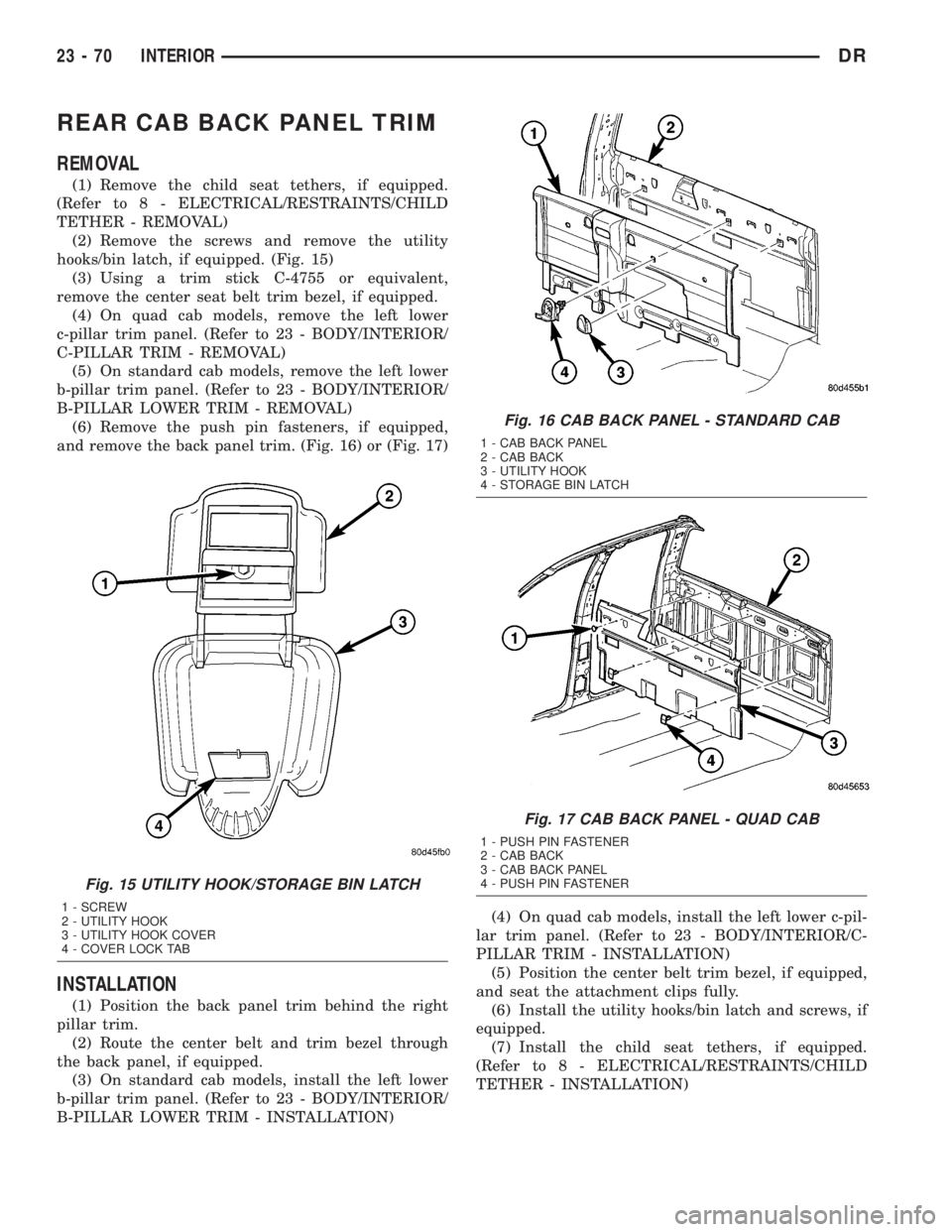
REAR CAB BACK PANEL TRIM
REMOVAL
(1) Remove the child seat tethers, if equipped.
(Refer to 8 - ELECTRICAL/RESTRAINTS/CHILD
TETHER - REMOVAL)
(2) Remove the screws and remove the utility
hooks/bin latch, if equipped. (Fig. 15)
(3) Using a trim stick C-4755 or equivalent,
remove the center seat belt trim bezel, if equipped.
(4) On quad cab models, remove the left lower
c-pillar trim panel. (Refer to 23 - BODY/INTERIOR/
C-PILLAR TRIM - REMOVAL)
(5) On standard cab models, remove the left lower
b-pillar trim panel. (Refer to 23 - BODY/INTERIOR/
B-PILLAR LOWER TRIM - REMOVAL)
(6) Remove the push pin fasteners, if equipped,
and remove the back panel trim. (Fig. 16) or (Fig. 17)
INSTALLATION
(1) Position the back panel trim behind the right
pillar trim.
(2) Route the center belt and trim bezel through
the back panel, if equipped.
(3) On standard cab models, install the left lower
b-pillar trim panel. (Refer to 23 - BODY/INTERIOR/
B-PILLAR LOWER TRIM - INSTALLATION)(4) On quad cab models, install the left lower c-pil-
lar trim panel. (Refer to 23 - BODY/INTERIOR/C-
PILLAR TRIM - INSTALLATION)
(5) Position the center belt trim bezel, if equipped,
and seat the attachment clips fully.
(6) Install the utility hooks/bin latch and screws, if
equipped.
(7) Install the child seat tethers, if equipped.
(Refer to 8 - ELECTRICAL/RESTRAINTS/CHILD
TETHER - INSTALLATION)
Fig. 15 UTILITY HOOK/STORAGE BIN LATCH
1 - SCREW
2 - UTILITY HOOK
3 - UTILITY HOOK COVER
4 - COVER LOCK TAB
Fig. 16 CAB BACK PANEL - STANDARD CAB
1 - CAB BACK PANEL
2 - CAB BACK
3 - UTILITY HOOK
4 - STORAGE BIN LATCH
Fig. 17 CAB BACK PANEL - QUAD CAB
1 - PUSH PIN FASTENER
2 - CAB BACK
3 - CAB BACK PANEL
4 - PUSH PIN FASTENER
23 - 70 INTERIORDR
Page 2646 of 2895
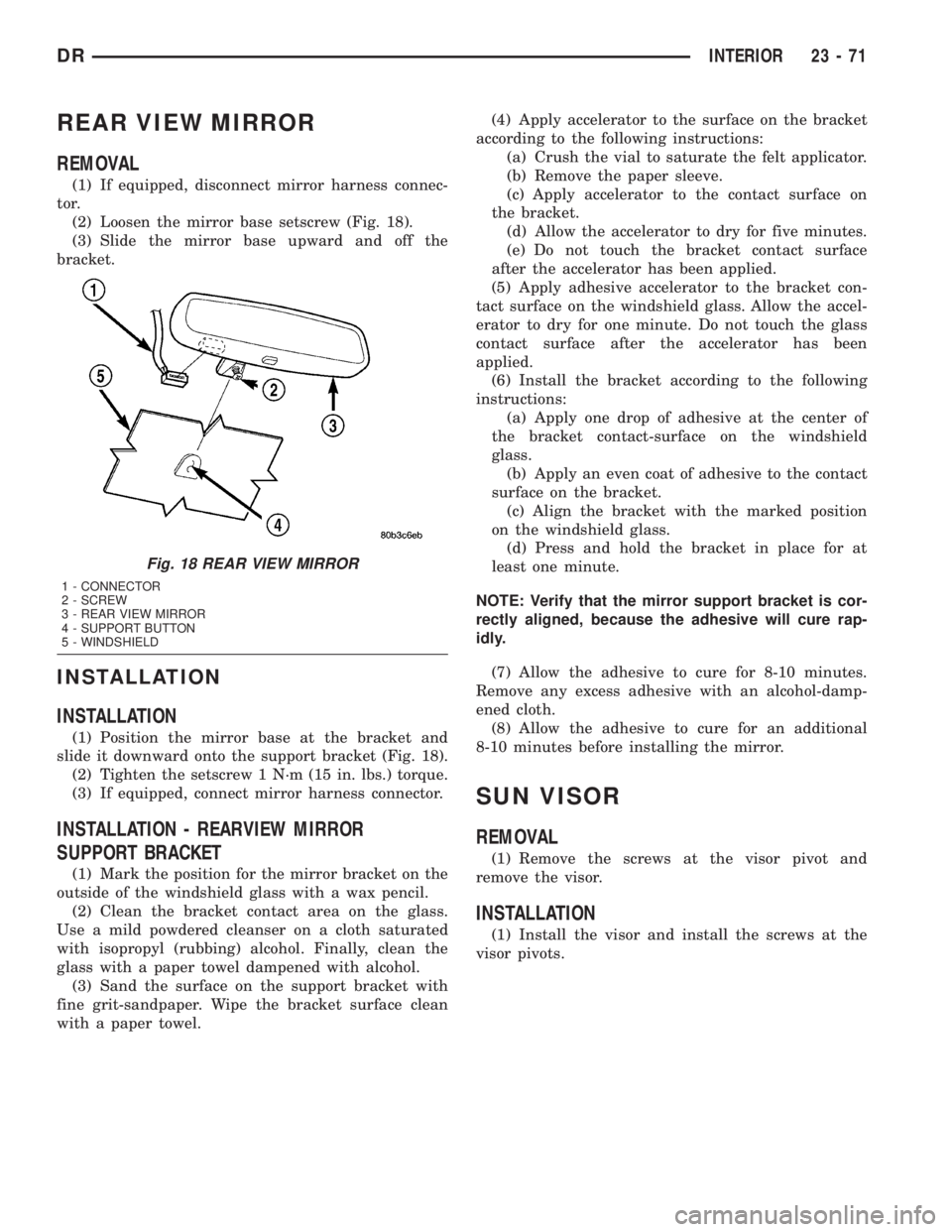
REAR VIEW MIRROR
REMOVAL
(1) If equipped, disconnect mirror harness connec-
tor.
(2) Loosen the mirror base setscrew (Fig. 18).
(3) Slide the mirror base upward and off the
bracket.
INSTALLATION
INSTALLATION
(1) Position the mirror base at the bracket and
slide it downward onto the support bracket (Fig. 18).
(2) Tighten the setscrew 1 N´m (15 in. lbs.) torque.
(3) If equipped, connect mirror harness connector.
INSTALLATION - REARVIEW MIRROR
SUPPORT BRACKET
(1) Mark the position for the mirror bracket on the
outside of the windshield glass with a wax pencil.
(2) Clean the bracket contact area on the glass.
Use a mild powdered cleanser on a cloth saturated
with isopropyl (rubbing) alcohol. Finally, clean the
glass with a paper towel dampened with alcohol.
(3) Sand the surface on the support bracket with
fine grit-sandpaper. Wipe the bracket surface clean
with a paper towel.(4) Apply accelerator to the surface on the bracket
according to the following instructions:
(a) Crush the vial to saturate the felt applicator.
(b) Remove the paper sleeve.
(c) Apply accelerator to the contact surface on
the bracket.
(d) Allow the accelerator to dry for five minutes.
(e) Do not touch the bracket contact surface
after the accelerator has been applied.
(5) Apply adhesive accelerator to the bracket con-
tact surface on the windshield glass. Allow the accel-
erator to dry for one minute. Do not touch the glass
contact surface after the accelerator has been
applied.
(6) Install the bracket according to the following
instructions:
(a) Apply one drop of adhesive at the center of
the bracket contact-surface on the windshield
glass.
(b) Apply an even coat of adhesive to the contact
surface on the bracket.
(c) Align the bracket with the marked position
on the windshield glass.
(d) Press and hold the bracket in place for at
least one minute.
NOTE: Verify that the mirror support bracket is cor-
rectly aligned, because the adhesive will cure rap-
idly.
(7) Allow the adhesive to cure for 8-10 minutes.
Remove any excess adhesive with an alcohol-damp-
ened cloth.
(8) Allow the adhesive to cure for an additional
8-10 minutes before installing the mirror.
SUN VISOR
REMOVAL
(1) Remove the screws at the visor pivot and
remove the visor.
INSTALLATION
(1) Install the visor and install the screws at the
visor pivots.
Fig. 18 REAR VIEW MIRROR
1 - CONNECTOR
2 - SCREW
3 - REAR VIEW MIRROR
4 - SUPPORT BUTTON
5 - WINDSHIELD
DRINTERIOR 23 - 71
Page 2647 of 2895
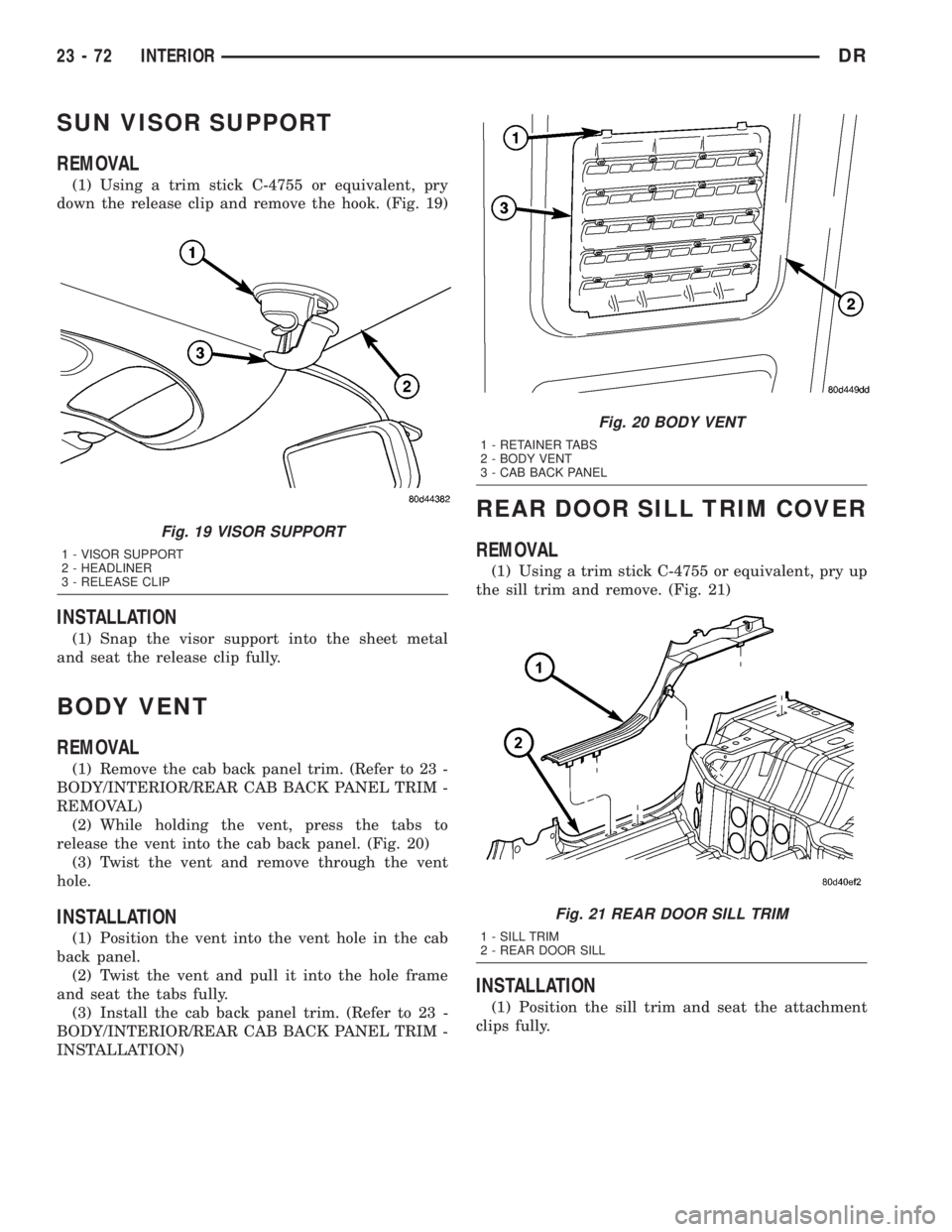
SUN VISOR SUPPORT
REMOVAL
(1) Using a trim stick C-4755 or equivalent, pry
down the release clip and remove the hook. (Fig. 19)
INSTALLATION
(1) Snap the visor support into the sheet metal
and seat the release clip fully.
BODY VENT
REMOVAL
(1) Remove the cab back panel trim. (Refer to 23 -
BODY/INTERIOR/REAR CAB BACK PANEL TRIM -
REMOVAL)
(2) While holding the vent, press the tabs to
release the vent into the cab back panel. (Fig. 20)
(3) Twist the vent and remove through the vent
hole.
INSTALLATION
(1) Position the vent into the vent hole in the cab
back panel.
(2) Twist the vent and pull it into the hole frame
and seat the tabs fully.
(3) Install the cab back panel trim. (Refer to 23 -
BODY/INTERIOR/REAR CAB BACK PANEL TRIM -
INSTALLATION)
REAR DOOR SILL TRIM COVER
REMOVAL
(1) Using a trim stick C-4755 or equivalent, pry up
the sill trim and remove. (Fig. 21)
INSTALLATION
(1) Position the sill trim and seat the attachment
clips fully.
Fig. 19 VISOR SUPPORT
1 - VISOR SUPPORT
2 - HEADLINER
3 - RELEASE CLIP
Fig. 20 BODY VENT
1 - RETAINER TABS
2 - BODY VENT
3 - CAB BACK PANEL
Fig. 21 REAR DOOR SILL TRIM
1 - SILL TRIM
2 - REAR DOOR SILL
23 - 72 INTERIORDR
Page 2648 of 2895
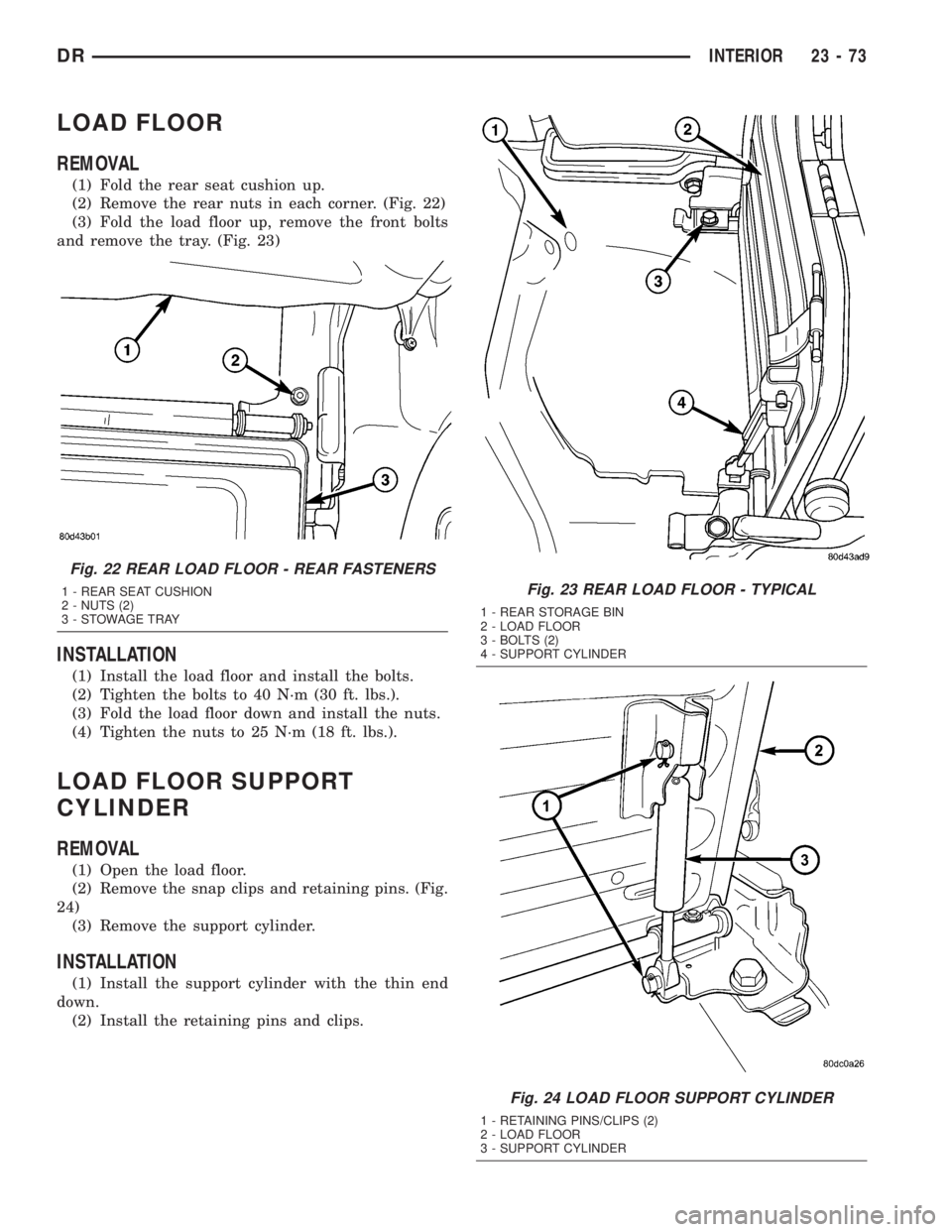
LOAD FLOOR
REMOVAL
(1) Fold the rear seat cushion up.
(2) Remove the rear nuts in each corner. (Fig. 22)
(3) Fold the load floor up, remove the front bolts
and remove the tray. (Fig. 23)
INSTALLATION
(1) Install the load floor and install the bolts.
(2) Tighten the bolts to 40 N´m (30 ft. lbs.).
(3) Fold the load floor down and install the nuts.
(4) Tighten the nuts to 25 N´m (18 ft. lbs.).
LOAD FLOOR SUPPORT
CYLINDER
REMOVAL
(1) Open the load floor.
(2) Remove the snap clips and retaining pins. (Fig.
24)
(3) Remove the support cylinder.
INSTALLATION
(1) Install the support cylinder with the thin end
down.
(2) Install the retaining pins and clips.
Fig. 22 REAR LOAD FLOOR - REAR FASTENERS
1 - REAR SEAT CUSHION
2 - NUTS (2)
3 - STOWAGE TRAYFig. 23 REAR LOAD FLOOR - TYPICAL
1 - REAR STORAGE BIN
2 - LOAD FLOOR
3 - BOLTS (2)
4 - SUPPORT CYLINDER
Fig. 24 LOAD FLOOR SUPPORT CYLINDER
1 - RETAINING PINS/CLIPS (2)
2 - LOAD FLOOR
3 - SUPPORT CYLINDER
DRINTERIOR 23 - 73
Page 2649 of 2895
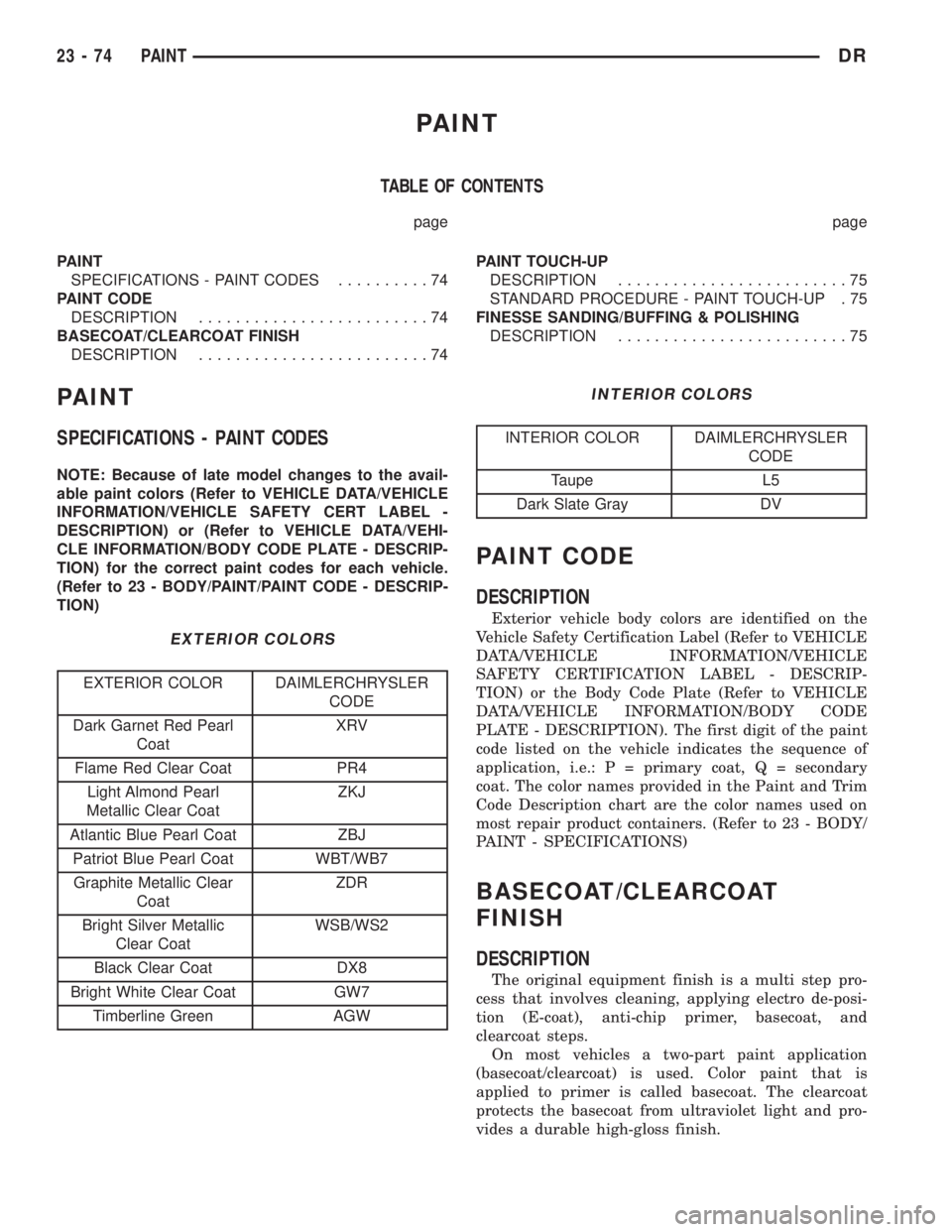
PAINT
TABLE OF CONTENTS
page page
PAINT
SPECIFICATIONS - PAINT CODES..........74
PAINT CODE
DESCRIPTION.........................74
BASECOAT/CLEARCOAT FINISH
DESCRIPTION.........................74PAINT TOUCH-UP
DESCRIPTION.........................75
STANDARD PROCEDURE - PAINT TOUCH-UP . 75
FINESSE SANDING/BUFFING & POLISHING
DESCRIPTION.........................75
PAINT
SPECIFICATIONS - PAINT CODES
NOTE: Because of late model changes to the avail-
able paint colors (Refer to VEHICLE DATA/VEHICLE
INFORMATION/VEHICLE SAFETY CERT LABEL -
DESCRIPTION) or (Refer to VEHICLE DATA/VEHI-
CLE INFORMATION/BODY CODE PLATE - DESCRIP-
TION) for the correct paint codes for each vehicle.
(Refer to 23 - BODY/PAINT/PAINT CODE - DESCRIP-
TION)
EXTERIOR COLORS
EXTERIOR COLOR DAIMLERCHRYSLER
CODE
Dark Garnet Red Pearl
CoatXRV
Flame Red Clear Coat PR4
Light Almond Pearl
Metallic Clear CoatZKJ
Atlantic Blue Pearl Coat ZBJ
Patriot Blue Pearl Coat WBT/WB7
Graphite Metallic Clear
CoatZDR
Bright Silver Metallic
Clear CoatWSB/WS2
Black Clear Coat DX8
Bright White Clear Coat GW7
Timberline Green AGW
INTERIOR COLORS
INTERIOR COLOR DAIMLERCHRYSLER
CODE
Taupe L5
Dark Slate Gray DV
PAINT CODE
DESCRIPTION
Exterior vehicle body colors are identified on the
Vehicle Safety Certification Label (Refer to VEHICLE
DATA/VEHICLE INFORMATION/VEHICLE
SAFETY CERTIFICATION LABEL - DESCRIP-
TION) or the Body Code Plate (Refer to VEHICLE
DATA/VEHICLE INFORMATION/BODY CODE
PLATE - DESCRIPTION). The first digit of the paint
code listed on the vehicle indicates the sequence of
application, i.e.: P = primary coat, Q = secondary
coat. The color names provided in the Paint and Trim
Code Description chart are the color names used on
most repair product containers. (Refer to 23 - BODY/
PAINT - SPECIFICATIONS)
BASECOAT/CLEARCOAT
FINISH
DESCRIPTION
The original equipment finish is a multi step pro-
cess that involves cleaning, applying electro de-posi-
tion (E-coat), anti-chip primer, basecoat, and
clearcoat steps.
On most vehicles a two-part paint application
(basecoat/clearcoat) is used. Color paint that is
applied to primer is called basecoat. The clearcoat
protects the basecoat from ultraviolet light and pro-
vides a durable high-gloss finish.
23 - 74 PAINTDR
Page 2650 of 2895
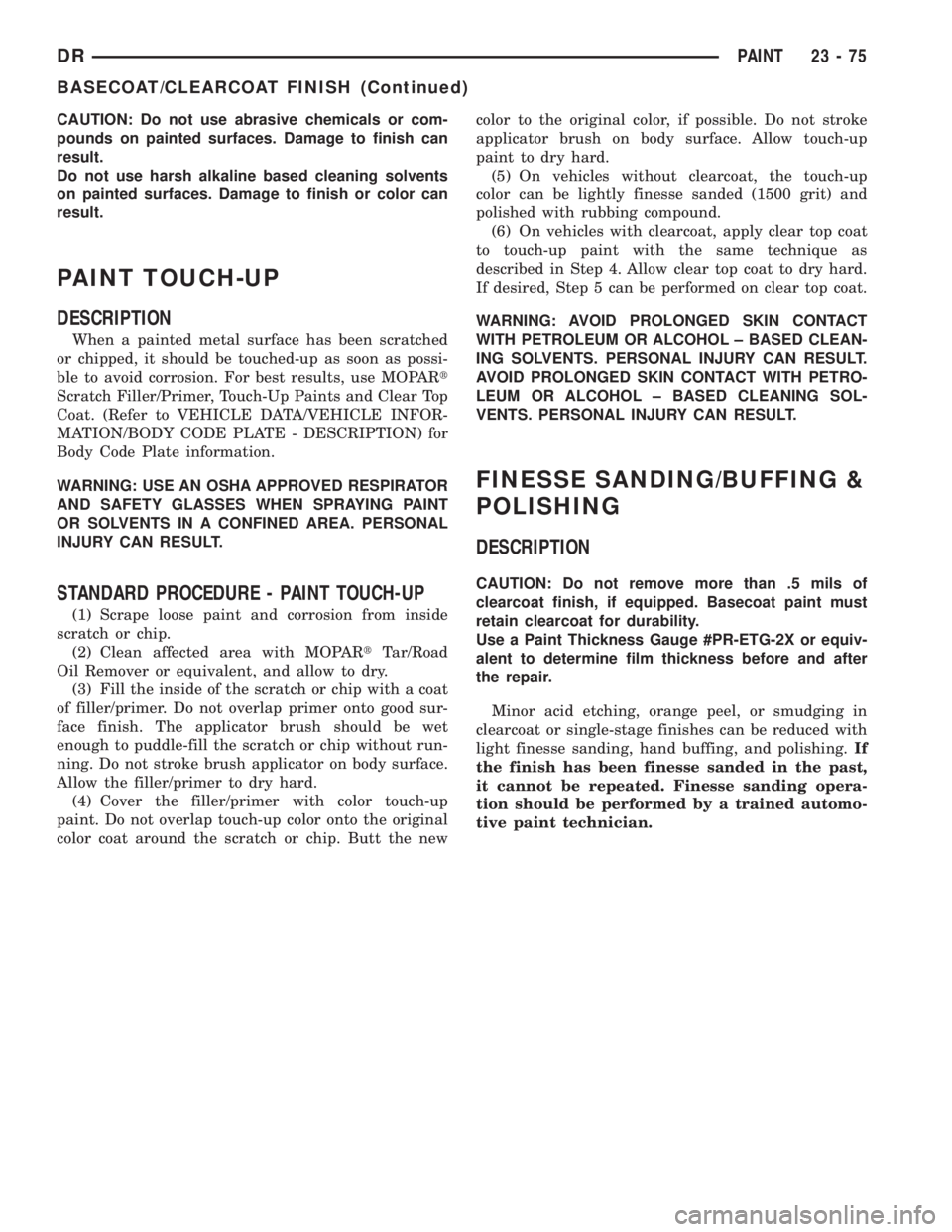
CAUTION: Do not use abrasive chemicals or com-
pounds on painted surfaces. Damage to finish can
result.
Do not use harsh alkaline based cleaning solvents
on painted surfaces. Damage to finish or color can
result.
PAINT TOUCH-UP
DESCRIPTION
When a painted metal surface has been scratched
or chipped, it should be touched-up as soon as possi-
ble to avoid corrosion. For best results, use MOPARt
Scratch Filler/Primer, Touch-Up Paints and Clear Top
Coat. (Refer to VEHICLE DATA/VEHICLE INFOR-
MATION/BODY CODE PLATE - DESCRIPTION) for
Body Code Plate information.
WARNING: USE AN OSHA APPROVED RESPIRATOR
AND SAFETY GLASSES WHEN SPRAYING PAINT
OR SOLVENTS IN A CONFINED AREA. PERSONAL
INJURY CAN RESULT.
STANDARD PROCEDURE - PAINT TOUCH-UP
(1) Scrape loose paint and corrosion from inside
scratch or chip.
(2) Clean affected area with MOPARtTar/Road
Oil Remover or equivalent, and allow to dry.
(3) Fill the inside of the scratch or chip with a coat
of filler/primer. Do not overlap primer onto good sur-
face finish. The applicator brush should be wet
enough to puddle-fill the scratch or chip without run-
ning. Do not stroke brush applicator on body surface.
Allow the filler/primer to dry hard.
(4) Cover the filler/primer with color touch-up
paint. Do not overlap touch-up color onto the original
color coat around the scratch or chip. Butt the newcolor to the original color, if possible. Do not stroke
applicator brush on body surface. Allow touch-up
paint to dry hard.
(5) On vehicles without clearcoat, the touch-up
color can be lightly finesse sanded (1500 grit) and
polished with rubbing compound.
(6) On vehicles with clearcoat, apply clear top coat
to touch-up paint with the same technique as
described in Step 4. Allow clear top coat to dry hard.
If desired, Step 5 can be performed on clear top coat.
WARNING: AVOID PROLONGED SKIN CONTACT
WITH PETROLEUM OR ALCOHOL ± BASED CLEAN-
ING SOLVENTS. PERSONAL INJURY CAN RESULT.
AVOID PROLONGED SKIN CONTACT WITH PETRO-
LEUM OR ALCOHOL ± BASED CLEANING SOL-
VENTS. PERSONAL INJURY CAN RESULT.
FINESSE SANDING/BUFFING &
POLISHING
DESCRIPTION
CAUTION: Do not remove more than .5 mils of
clearcoat finish, if equipped. Basecoat paint must
retain clearcoat for durability.
Use a Paint Thickness Gauge #PR-ETG-2X or equiv-
alent to determine film thickness before and after
the repair.
Minor acid etching, orange peel, or smudging in
clearcoat or single-stage finishes can be reduced with
light finesse sanding, hand buffing, and polishing.If
the finish has been finesse sanded in the past,
it cannot be repeated. Finesse sanding opera-
tion should be performed by a trained automo-
tive paint technician.
DRPAINT 23 - 75
BASECOAT/CLEARCOAT FINISH (Continued)